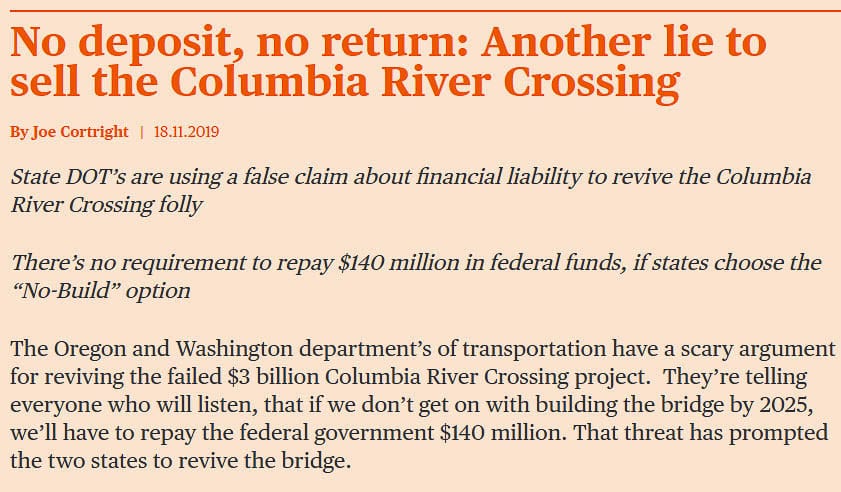Economist Joe Cortright: ‘State DOT’s are using a false claim about financial liability to revive the Columbia River Crossing folly’
Economist Joe Cortright has been a long-time leader in analyzing regional transportation projects. He was active in evaluating the original Columbia River Crossing (CRC) in addition to studying many different aspects of numerous transportation proposals.
The recent effort to replace the Interstate Bridge is allegedly due to the fact that Oregon and Washington spent $140 million Federal Highway Administration (FHWA) funds on the failed CRC. Oregon and Washington legislators claim they “must” begin building something by Sept. 2025 or they will be required to repay that money. Washington would owe $46 million, Oregon $93 million.
Cortright says that is not true.

A year ago, Cortright wrote in The City Observatory: “State DOT’s are using a false claim about financial liability to revive the Columbia River Crossing folly. There’s no requirement to repay $140 million in federal funds, if states choose the ‘no nuild’ option.”
That’s an eye-opener for most citizens. Sadly, none of the media picked up on Cortright’s claim. “They’re telling everyone who will listen, that if we don’t get on with building the bridge by 2025, we’ll have to repay the federal government $140 million. That threat has prompted the two states to revive the bridge.
“Choose the ‘no build’ option; no repayment required,” says Cortright. “The Federal Highway Administration does not require funds to be repaid, if as part of the environmental review process, the sponsoring agency selects the ‘No Build’ option.”
Here’s how Cortright explains the FHWA process:
“The FHWA does not require repayment of PE (preliminary engineering) funds when project termination is directly related to compliance with another Federal law. For instance, repayment of reimbursed PE costs would not be required if FHWA and a State DOT determine that a project should not be advanced as a result of findings during the National Environmental Policy Act (NEPA) process. To do otherwise could skew the NEPA process by causing a State DOT to favor a ‘build’ alternative to avoid repaying PE costs incurred during the NEPA review.”
“Show me where somebody chose the no build option under NEPA and had to write a check back to the federal government for not going ahead with a highway project.”
— Economist Joe Cortright
There is an example of this in Salem, Oregon. They spent $6 million planning a new bridge across the Willamette River just north of downtown Salem. Just as with the CRC proposal, the project has floundered over community environmental concerns, and problematic and unresolved funding issues.
In Feb. 2019, the Salem City Council formally withdrew its support for the project and instructed ODOT to proceed with the no build option. “Salem rejects wrong bridge” read the headline. No repayment was required according to Cortright.
The “no build” option was included as part of the CRC Environmental Impact Statement process. Choosing that option would eliminate the liability for repaying the federal government points out Cortright.
“There’s no reason to have the costs of that failed effort hanging over people’s heads as they consider what to do next,” he said. “It’s dishonest of the state departments of transportation to tell people there’s a $140 million penalty for not moving forward with this project.”
Clark County Today asked Cortright about the issue. He shared some interesting insights.
“I actually had a conversation with Greg Johnson (the Interstate Replacement Bridge Administrator) and said you know, you’re absolutely wrong on this. There’s no repayment if you do the ‘no build.’ His response was there’s just no way we do the ‘no build.’
“I know the two DOT’s don’t want to choose the ‘no build’,” Cortright said. “It’s just a fiction that they’ve created in order to build a major bridge project. It’s designed to create the illusion for everyone else that they don’t have any choices, but in fact they do.”
Cortright mentioned that they are revisiting the Purpose and Need on the project. “It is sort of the most fundamental step. It says what’s the problem we’re trying to solve? How do we define it?”
The IBRP team could modify or totally change the Purpose and Need, potentially providing other options like a tunnel (or another location). But Cortright believes they are using the short time frame to say “well, you just don’t have the time to consider all those other things.”
Who would have to choose the “no build’’ option?
Cortright said technically it’s the FHWA that makes the choice. He pointed out, like in the Salem example, that when the “partners” (Salem and ODOT) reject what’s been worked on, “it’s a fait accompli. If the partners don’t agree, you chose the ‘no build’ option,” he said.

He pointed out a recent example. “Another classic example of this is the southwest light rail,” he said. “Two weeks ago the voters in the Portland area said ‘no, we don’t want a big transportation tax.’ TriMet said, ‘we’d really like to build this but we don’t have enough money. So we’re going no-build.’”
The TriMet Southwest Light Rail Project was using federal transit dollars, whereas the CRC used federal highway money. But they both have to go through the NEPA environmental review process. Cortright believes if you decide a project doesn’t pass the NEPA process, for whatever reason, there is no requirement to repay the government for planning money expended.
“There are all kinds of projects that march through this NEPA process and people decide not to go through with them,’’ he said. “I don’t know of any examples of where people have had to repay the federal government. That would be the question to ask. Show me where somebody chose the no build option under NEPA and had to write a check back to the federal government for not going ahead with a highway project.”
Clark County Today reached out to Interstate Bridge Replacement Project Administrator Greg Johnson for responses to the issues raised by Cortright.
There’s no requirement to repay $140 million in federal funds, if states choose the “no build” option. Is this an accurate statement according to the IBRP team?
“In our judgment, the statement is not accurate, but the answer to your question requires context: FHWA does have regulations and guidance to authorize waiving federal repayment if the reason for waiving is considered reasonable,’’ Johnson said. “The question then turns to whether or not FHWA will see a no build option as reasonable for the IBR Program. FHWA issued a Record of Decision in 2011 with a preferred alternative to address a specific purpose and need.
“The need for the program has not diminished over the last 9 years. While we are only in the early stages of working with stakeholders and the public to identify Purpose and Need for the Interstate Bridge Replacement Program, we know that all six of the problems previously identified remain current issues that have not been addressed: safety, seismic vulnerability, limited public transportation, impaired freight movement, growing travel demand and congestion, and substandard bicycle and pedestrian facilities. Choosing a ‘no build’ option at this point would not address these significant transportation problems.”
If that is true, who would have to choose the “no build option” in Washington?
“Ultimately, FHWA, or FHWA and FTA, would have to approve that the ‘no build’ option satisfies the Purpose and Need, or that the ‘no build’ option must be chosen because the environmental impacts of choosing a build option are insurmountable,’’ Johnson said. “To arrive at this decision, the IBR Program Administrator, WSDOT, and ODOT would have to co-sign the environmental document, along with the federal lead(s).”
Cortright references the Federal Highway Administration. Is he correctly interpreting the FHA regulations?
“The statement above is taken directly from FHWA Order 5020.1A,’’ Johnson said. “This statement provides context for how to reasonably consider the effect of choosing the ‘no build’ alternative when determining a state’s repayment obligation. Other elements to consider when determining reasonableness include satisfaction of the Purpose and Need, and timing and intent.
“The Purpose and Need consideration is described above in your first question,’’ Johnson said. “For timing and intent, FHWA might not consider it a reasonable justification if previously authorized NEPA decisions were re-evaluated and the preferred alternative were changed to ‘no build’ in order to avoid repayment. FHWA’s intent is to ensure appropriate stewardship of the nation’s Federal-aid Highway Program, with money spent wisely to solve transportation problems.
“ODOT and WSDOT have a repayment obligation to FHWA. The IBR Program is pursuing the development of an alternative that would meet an updated Purpose and Need and meet FHWA’s repayment extension requirements. If we did not pursue consideration of an Interstate Bridge replacement alternative, ODOT and WSDOT would be required to repay federal funds spent on previous planning efforts.”
Johnson was then asked how much of the $46 million that is Washington’s share of the FHA funds, would be classified as “Preliminary Engineering Costs?’’ How much of the $94 million that is Oregon’s share of the FHA funds would be classified as “Preliminary Engineering Costs?”
“Typically our agreements do not distinguish different aspects of preliminary engineering so the program would expect that our repayment obligation is for the entire amount,” Johnson said.




